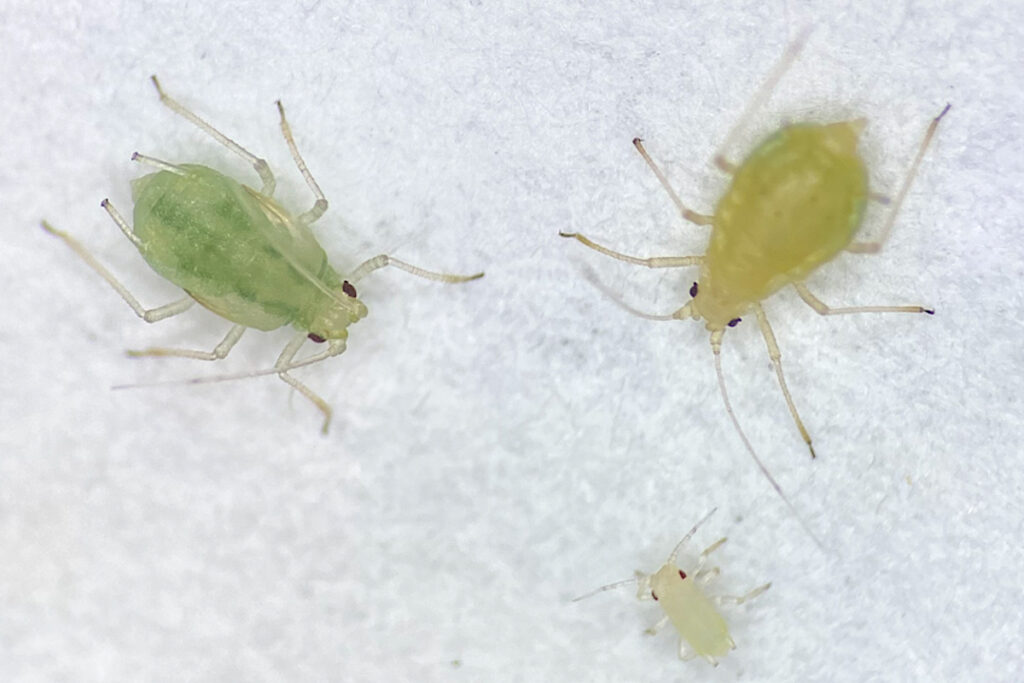Did you know that insect microbes can play a key role in an insect’s ability to resist pesticides and transmit viruses?
Experimental new research, being undertaken as part of the Australian Grains Pest Innovation Program (AGPIP), is investigating ways to manipulate tiny insect microbes called endosymbionts to improve pest control and reduce levels of insecticide resistance and virus transmission for key grain pests.
Endosymbionts: a new frontier in pest management
Endosymbionts are bacteria that live within the cells of other organisms in a symbiotic relationship. Endosymbionts co-evolve within their hosts over thousands (or in some cases, millions) of years and become integral to many different survival processes. In fact, some of the earliest known examples of endosymbiosis are thought to have supported the evolution of complex organisms.
In insects, endosymbionts can play a vital role in nutrition, reproduction and resistance to external pressures, such as insecticides or climatic variations, as well as impact upon the ability to transmit viruses and susceptibility to predators.
The AGPIP research team is looking at how manipulation of endosymbionts can be used to disrupt these processes in aphids and other pest species to reduce crop damage and plant virus transmission, and to increase susceptibility to insecticides and predators, such as parasitoid wasp species.
The Pest & Environmental Adaptation Research Group (PEARG) at the University of Melbourne, who are undertaking the endosymbiont component of the AGPIP research in partnership with Cesar Australia, have previously been involved in endosymbiont manipulation to reduce the transmission risk of dengue virus in mosquitoes.
This dengue virus research involved transferring an endosymbiont discovered in Drosophila flies, Wolbachia, into target mosquitoes.
The introduction of Wolbachia into these mosquitoes reduces their ability to spread the disease amongst human populations, either by suppressing the population or by directly blocking the mosquito dengue transmission ability.
Endosymbionts and agriculture
More recent work by the PEARG research team with collaborators in China has shown the potential for this research to be applied in an agricultural setting.
The research focused on the melon aphid (Aphis gossypii; otherwise known as the cotton aphid), which carries a number of endosymbionts – particularly Buchnera aphidicola. Buchnera sp. are the primary aphid endosymbiont and can be important for providing nutritional services in many aphid species.
Testing of A. gossypii as part of this research indicated that the aphid samples with higher concentrations of B. aphidicola had higher levels of resistance to insecticides including imidacloprid and sulfoxaflor. By artificially reducing the concentration of B. aphidicola in these more resistant strains of A. gossypii by applying antibiotic treatments, the researchers were able to increase sensitivity of these individuals to imidacloprid and make the aphids susceptible to the chemical once again.
The AGPIP research will initially look to build on this work by applying endosymbiont manipulation to three key aphid grain pests: the green peach aphid (Myzus persicae), the Russian wheat aphid (Diuraphis noxia) and the oat aphid (Rhopalosiphum padi).
This will involve endosymbionts being transferred from a number of aphid species into the target species via microinjection, as well as the suppression of endosymbionts in pest aphids through the application of heat and chemical treatments.
The team will then determine if a change in endosymbiont composition in these aphid species has an effect on different traits, such as susceptibility to insecticides and predators or propensity to transmit viruses.

In the future there is the possibility that the new strains of aphids demonstrating favourable traits could be released in the field with the aim of displacing aphid populations with less desirable traits.
The AGPIP research team have already begun the process of identifying endosymbionts present in secondary aphid species as candidates for microinjection into the target species and initial microinjection and microbe suppression experiments are already underway.
Similar work is also planned on endosymbionts in pest moth species and the beneficial species that attack the larval stage. This research aims to increase rates of parasitism and predation of these pests. Both the resistance of beneficial organisms to pesticides and their reproductive rates could be increased through endosymbionts, thus increasing their efficiency in controlling pests by giving them a fitness advantage.
While the potential for field application will not be immediate, we hope that these experiments will in the long term support the development of new non-chemical pest management options so that growers can reduce their insecticide usage and thereby reduce the selection pressures that drive resistance in these pest species.
Acknowledgements
Australian Grains Pest Innovation Program is a collaboration between the Pest & Environmental Adaption Research Group at the University of Melbourne and Cesar Australia. The Program is a co-investment by the Grains Research and Development Corporation and the University of Melbourne, together with in-kind contributions from all program partners.
Additional thanks to Professor Ary Hoffmann, Pest & Environmental Adaptation Research Group (PEARG), for his assistance in developing the article contents.
Cover image: Photo by Andrew Weeks, Cesar Australia
